Agapanthus (agapanthus genus)
bloulelie [Afrikaans]; ubani(-oluncane), uhlakahla
[Zulu]; hlakahla [Swazi]; ugebeleweni [Xhosa]; leta-laphofu [South
Sotho]
Life
> eukaryotes >
Archaeoplastida >
Chloroplastida
>
Charophyta > Streptophytina > Plantae (land plants)
> Tracheophyta (vascular plants) > Euphyllophyta > Lignophyta (woody plants)
> Spermatophyta (seed plants) > Angiospermae (flowering
plants)
> Monocotyledons > Order: Asparagales
> Family: Amaryllidaceae
Six species, all endemic to southern Africa. Previously
placed in the Agapanthaceae.
Species native to southern Africa
List from
Plants
of Southern Africa - an Online Checklist (SANBI).
|
Agapanthus africanus
(Cape agapanthus) Occurs in fynbos on rocky, sandy slopes,
from Cape Peninsula to Swellendam in the Western Cape, South Africa. What
used to be known as Agapanthus walshii has now been relegated to a
subspecies of Agapanthus africanus. |
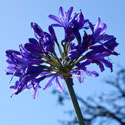 |
|
Agapanthus campanulatus
(Bell agapanthus) Natural distribution includes the
northeastern regions of the Eastern Cape, KwaZulu-Natal, Free State, Gauteng
(all in South Africa) and Lesotho. Occurs in most grassland on rocky
hillsides. |
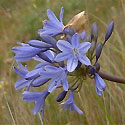 |
Agapanthus
caulescens Natural distribution includes
KwaZulu-Natal, Mpumalanga (both in South Africa) and Swaziland. Found in
rocky areas. |
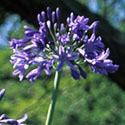 |
Agapanthus
codii Natural distribution is limited to
Limpopo Province in South Africa. |
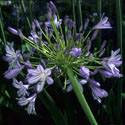 |
Agapanthus
inapertus (Drakensberg agapanthus, Drooping agapanthus)
Natural distribution includes northern KwaZulu-Natal, Mpumalanga, Gauteng
and Limpopo (all in South Africa), and Swaziland. Grows on forest margins,
in grassland and in the mountains. |
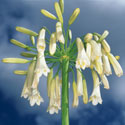 |
|
Agapanthus praecox
(Common agapanthus) Natural distribution extends from
Knysna in the Western Cape, through the Eastern Cape to southern
KwaZulu-Natal. Occurs in grasslands on rocky hillsides. This is the species
most commonly cultivated in gardens. |
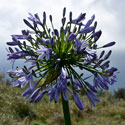 |
Identification of species
The taxonomy of Agapanthus has been
confused due to the fact that some of the species look very similar
to one another as well as because they hybridise freely under
cultivation (Leighton 1965 p. 13). For quite some time prior
to Leighton's 1965 revision, all open-flowered Agapanthus
were known as Agapanthus africanus and this nomenclature has
fed through to the ethnobotanical and pharmacological literature.
Watt and Breyer-Brandwijk (1962 p. 669) in their monumental treatise
on the Medicinal and Poisonous Plants of Southern and Eastern
Africa, have quite a long section on Agapanthus africanus
referring to its use by Xhosa-speaking people in the Transkei (now
part of the Eastern Cape), Zulu people who traditionally lived in
what is now KwaZulu-Natal, and South Sotho people who traditionally
lived mainly in what is today the Free State and Lesotho.
Agapanthus africanus in the restricted, modern sense is a
species with a restricted distribution extending from Cape Town to
Swellendam and does not grow well under cultivation (Manning et
al. 2002). Clearly, therefore, Watt and Breyer-Brandwijk
(1962) are referring to Agapanthus africanus in the old,
broad, sense and most of what they have to say about its medicinal
properties probably applies mainly to species that occur mainly in
the Eswhat is now understood as Agapanthus praecox, Agapanthus
campanulatus and Agapanthus caulescens. The same applies
to the accounts on Agapanthus in Hutchings et al.
(1996) and van Wyk et al. (2000).
Rhizomes and roots contain:
- saponins and sapogenins (reduce
inflammation [anti-inflammatory],
reduce swelling [anti-oedema],
suppress coughs [antitussive],
help immunoregulation)
- agapanthagenin (van Wyk et al. 2000)
- 7-dehydroagapanthagenin (Gonzalez et al. in
Hutchings et al. 1996)
- 8(14)-dehydroagapanthagenin (Gonzalez et al. in
Hutchings et al. 1996)
- 9(11)-dehydroagapanthagenin (Gonzalez et al. in
Hutchings et al. 1996)
- yuccagenin (Gonzalez et al. in Hutchings et
al. 1996)
-
chalconoids (chalcones) (have antibacterial, antifungal,
antitumor and anti-inflammatory properties)
- dihydrochalcone (Kamara et al. 2005)
- isoliquiritigenin (precursor of dihydrochalcone) (Kamara
et al. 2005)
- In Xhosa and Zulu herbal medicine, a decoction of the root
of Agapanthus (sometimes also with roots of
Typha capensis
[Bulrush]) is taken by women orally or rectally in the last
three months of pregnancy to ensure a healthy child and ease
childbirth. The decoction is said to have a mild laxative
effect, it ensures that the child will not develop bowel
problems, and ensures that the placenta will be born without
problems. The child is evidently given the same medicine before
suckling from the mother for the first time. (Watt and
Breyer-Brandwijk 1962; Hutchings et al. 1996). The
decoction is also used in a more concentrated form to encourage
or induce labour. It has been shown experimentally that a
decoction of this sort causes smooth muscle contractions (Veale
et al. 1999 and previous work).
- In Zulu herbal medicine, root infusions are used in enemas
given to young children for an ailment referred to as inyoni
(Hutchings et al. 1996).
- In South Sotho herbal medicine, a lotion is made from the
crushed root of
Agapanthus campanulatus and applied to a new-born child
to ensure strength (Watt and Breyer-Brandwijk 1962).
- The root of Agapanthus is beaten up in cold water
together with the root of
Dianthus until
it froths and then the whole body is washed in the liquid to
relieve paralysis that has been causing abdominal pains (Watt
and Breyer-Brandwijk 1962).
- In Zulu herbal medicine, an infusion of the root is used
(how?) for treating chest troubles, especially of benefit with
chronic coughs. The benefit, rather puzzlingly, comes through
having an emetic (vomiting) action (Watt and Breyer-Brandwijk
1962).
- In Zulu herbal medicine, a hot infusion of the root of
Agapanthus is taken daily as an emetic (causes vomiting), to
treat serious heart disease (Watt and Breyer-Brandwijk 1962).
- The bulb of Agapanthus praecox has been used as a
Zulu aphrodisiac (Watt and Breyer-Brandwijk 1962).
Toxic effects
- Suspected of causing human poisoning through incorrect use
as a medicine (Watt and Breyer-Brandwijk 1962).
- The sap causes severe ulceration of the mouth (Veale et
al. 1992 in Hutchings et al. 1996).
Links
Publications
-
Goldblatt P. and Manning J. 2000. Cape Plants - A Conspectus of the Cape
Flora of South Africa. National Botanical Institute, Pretoria and
Missouri Botanical Garden Press, Missouri.
- Hutchings, A., Scott, A.H., Lewis, G. and Cunningham, A.
1996. Zulu Medicinal Plants - an Inventory. University of
Natal Press, Pietermaritzburg.
- Kamara B.I., Manong D.T.L. and Brandt E.V. 2005. Isolation
and synthesis of a dimeric dihydrochalcone from Agapanthus
africanus. Phytochemistry 66(10): 1126-1132.
doi:10.1016/j.phytochem.2005.04.007
-
Leighton F.M. 1965. The genus Agapanthus
L'Hérit. Journal of South African Botany Suppl. 4: 1-50.
-
Manning J., Goldblatt P. and Snijman D. 2002. The Color
Encyclopedia of Cape Bulbs. Timber Press, Portland.
-
van Wyk B.E., Oudtshoorn B. and Gericke N. 2000. Medicinal Plants of
South Africa. 2nd edition. Briza Publications, Pretoria.
-
Veale D.J.H., Furman K.I. and Oliver D.W. 1992. South African traditional
herbal medicines used during pregnancy and childbirth. Journal of
Ethnopharmacology 36: 185-191.
-
Veale D.J.H., Havlik I., Oliver D.W. and Dekker T.G. 1999. Pharmacological
effects of Agapanthus africanus on the isolated rat uterus. Journal
of Ethnopharmacology 66(3): 257-262. doi:10.1016/S0378-8741(98)00224-4
-
Watt, J.M. and Breyer-Brandwijk, M.G. 1962. The Medicinal and Poisonous
Plants of Southern and Eastern Africa. Second Edition. E. & S. Livingstone
Ltd., Edinburgh.
- Zonneveld B.J.M. and Duncan G.D. 2003. Taxonomic
implications of genome size and pollen colour and vitality for
species of Agapanthus L'Heritier (Agapanthaceae). Plant
Syst. Evol. 241: 115-123.
|
